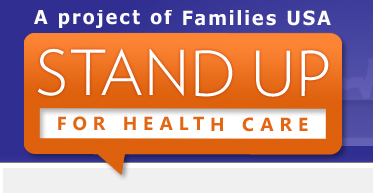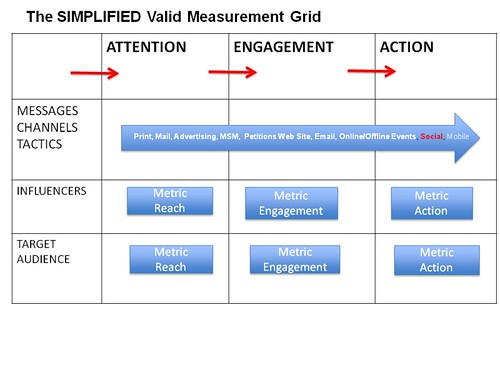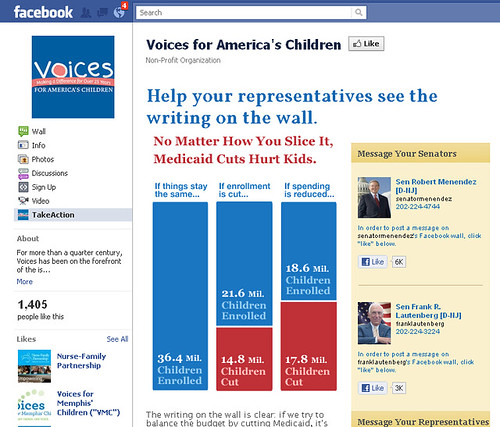
With the debt ceiling debate raging in our nation’s capital, health care advocates have kicked into high gear and are using new social media tactics to engage elected officials in the fight to protect health care rights — Medicare, Medicaid, and the Affordable Care Act.
Families USA is an organization fighting for affordable health care for all Americans. Their web site tools provide useful information for grassroots advocates or anyone for that matter to stay informed on health care-related topics such as the proposed Medicaid cuts in the budget that are currently being debated in Congress. They have a online resource for understanding the Affordable Care Act and potential roadblocks to its implementation.
They are integrating social media tactics to their online advocacy tool box with this Twitter tool. Its Stand Up For Health Care, a project of Families USA, has created a Twitter tool that easily lets your identify Twitter names for your US Representatives, Senators and Governor by typing your zip code. You just type in your zip code, and their Twitter handles are displayed with buttons that allow you to easily Tweet them about not cutting Medicaid.
The holy grail of social media impact is on the ground social change, whether that’s impacting policy debates or large-scale behavior change. One can’t really claim cause and effect here, but social media is becoming an important tool in grassroots organizing. At minimum, this application lets people air their concerns to legislators and policy makers easily through Twitter and can amplify more traditional tactics such as email campaigns and signing online/offline petitions.
In this example of using grassroots organizing to influence grass tops debates, how do we measure it? Use the “Valid Measurement Grid”

Back in June, I wrote a post about the “Valid Metrics Grid” developed by measurement professionals to launch the debate about standardization of social media metrics. The above grid is a very much simplified version.
Putting your strategy on the grid can only help you design a measurement strategy, but more importantly help your strategy have more impact. The grid itself can be customized to your organization’s way of thinking about its marketing funnel, target audiences, and tactics.
The columns represent a simplified marketing funnel – how people make “purchase” decisions or in this case advocacy “action” decisions. Your organization’s “funnel” for advocacy may look different, it may have more stages. A funnel for donations or volunteering may be different as well. The important thing is that you need to have tactics to get people to the next stage and metrics to measure effectiveness.
The rows are your audience. There are two types of audiences. The messages or story is created, shared via intermediaries or influencers: This can be legislators, journalists, or other influencers. The message is consumed by a target audience that goes through the stages of attention, engagement, and finally action.
One could take each channel and place it on the grid, understanding that not all channels are appropriate or effective for getting people up to the next level.

Apps allow citizens to use their zip codes to look up their elected officials and voice their concerns or support on a policy issue are not unique to Twitter as I learned from posting about the App on Google+. Voice for America’s Children has a similar app on Facebook.
It also made me wonder about the Google + and it is potential for social activism and organizing. I posted this question on Google + = “Are there social change activists on Google + or they waiting for the early adopters and geeks to clear the path?”
Stephen Downes said:
Google is very deliberately designing G+ to not be a broadcasting network, and a lot of social activist stuff is about broadcasting messages. G+ is very very cleverly designed. The broadcast part will come when Sparks kicks in big time. It’s pretty difficult to create circles or groups of like-minded individuals in G+. Clusters will form around Sparks content. If they can sustain the network component – people talking more or less disjointedly with people they’re connected to – then marketers, including activists, will pay (and need to pay) dearly for a marketing push through Sparks.
Activists – genuine activists, not just marketing agencies – need to figure out how to sustain collective discussion in a system designed to constrain it and shape it. Or, failing that, to come up with an alternative to G+.
Nathan Henderson-James added:
Most of the social change folks I work with work with membership organizations and try to mobilize mass numbers (that’s just my world, other people’s social change activist circle’s mileage may vary). And most of those folks are busy working with folks who aren’t as wired or use the web differently from early adopters. So for my very specific circle, the people who I’ve seen on it tend to be the geeky ones and they aren’t using it for their organizing. They are trying to figure out how it is different from Twitter and Facebook. Most everyone else is kinda like, great, another social media thing to try to understand. Just tell me how to use it. These are mostly people who share pics of their kids on FB and are never on Twitter. So… for my specific circle, it’s not worth the time spent yet.
Mark Dilley made a proposal about LinkLanguage, an elegant solution to the lack of hashtags, to help sustain a conversation on Google + related to activism.
Stephen Downes pointed out:
However, when I tested it in Sparks, like this – https://plus.google.com/u/0/sparks/interests/LinkLanguage – it appears that G+ actually extracts the words out of the search string, even if they are mashed together. That’s probably why hashtags don’t work either. Even nonsense strings – https://plus.google.com/u/0/sparks/interests/farsingmallow – resolve into ordinary words.
This is actually pretty deeply disturbing. It means that Google basically takes a search string and matches it against a previously defined vocabulary. You can only search for what Google allows in Sparks. This is a terribly broken system.
So, for now advocates are using Twitter/Facebook tools because the issues are pressing and we haven’t yet figured out how or if Google + can or will become a useful platform for social change work. Meanwhile, early adopter social activists are discussing this.
